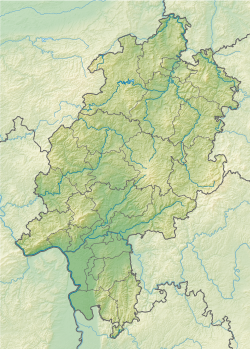Menhir of waves
| Menhir of waves | ||
|---|---|---|
|
Menhir of waves |
||
|
|
||
| Coordinates | 51 ° 10 ′ 29 ″ N , 9 ° 0 ′ 6 ″ E | |
| place | Edertal , OT Wellen , Hessen , Germany | |
The menhir of waves is an archaeological rarity among the menhirs in the Fritzlar - Kassel area due to its incised pattern . The menhir made of red sandstone , carved with a herringbone pattern and four parallel lines, is one of the rare ornate stones in the area , along with the two Ellenberg steles .
Find history
The stone was discovered in 1961 in the Edertal district of Wellen during gravel extraction work and removed by a private person. Today it is sheltered from the weather in the Edertal district of Bringhausen above the Edersee in the freely accessible entrance area of a private holiday home. A copy is in the Hessian State Museum in Kassel .
The find was torn from its archaeological context, so that no conclusions from the secondary finds or the layers of the earth are possible. Similar herringbone patterns were discovered on the end stone of the stone chamber grave of Züschen , on cups from the cup culture and on one of the two menhirs from Ellenberg, which are kept in the Hessian State Museum in Kassel . In further excavations and as individual finds, a musk ox skull , ribbon ceramics , large urns with corpse burns, as well as Roman coins and bone combs from later times from the migration period were found in waves .
procurement
The megalithic slab is 1.3 m wide, 1.5 m high and 25 cm thick. There are numerous ritual bowls on the top . A special feature, as with the Ellenberger menhirs, is the bevelling of the narrow sides towards the back. The front is rounded. The menhir is to be regarded as a sculptural development due to its late cultural and historical appearance (around 2500 BC). It was not only part of a religious center of a pre-Christian clan, or a place of worship of a deity, as a place of sacrifice or cult, but can also be assessed as an artifact by an anonymous artist .
literature
- Klaus Albrecht: The Stele of Wellen (Gde. Edertal, Schwalm-Eder-Kreis) - a Neolithic lunar calendar? In: Archaeological correspondence sheet. Volume 30, 2000, pp. 45-51.
- Eduard Brauns: Hiking and travel guide through North Hesse and Waldeck. A. Bernecker, Melsungen, 1971, p. 143 and 149
- Wolfgang Dehn, Josef Röder: Hessian stone boxes and early metal. In: Find reports from Hessen. Volume 19/20, 1980, p. 166.
- Greaves: Upper Hesse, Kurhessen, Waldeck. Grieben Verlag, Munich, Volume 230, 8th edition, 1981, p. 99.
- Johannes Groht : Menhirs in Germany. State Office for Monument Preservation and Archeology Saxony-Anhalt, Halle (Saale) 2013, ISBN 978-3-943904-18-5 , pp. 54, 136, 154.
- Fritz-Rudolf Herrmann , Albrecht Jockenhövel : The prehistory of Hesse . Theiss, Stuttgart 1990, ISBN 3-8062-0458-6 , p. 355.
- Irene Kappel: Stone chamber graves and menhirs in Northern Hesse. Staatliche Kunstsammlungen Kassel (Ed.), Issue 5, 1978, p. 61, pp. 69–71.
- Dirk Raetzel-Fabian : The first farming cultures. New Stone Age in Northern Hesse (= prehistory and early history in the Hessisches Landesmuseum Kassel. Volume 2). 2nd ed., Kassel 2000, pp. 139–148.
Web links
- Menhir of waves
- The menhir waves on Grosssteingraeber.de
- The Megalithic Portal: waves menhir
- Klaus Albrecht: The Stele of Waves: Lunar Calendar - Moon Symbolism? , November 14, 1999
- Jürgen Hamel: Comments on Klaus Albrecht - "The Stele of Waves: Lunar Calendar - Moon Symbolism?" , May 16, 2000

